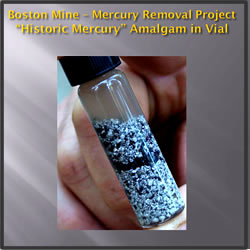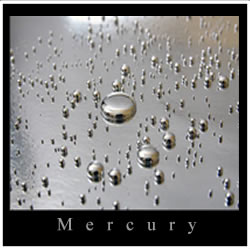Publications
California - Sierra Nevada Region
SN1) Boston Mine: Mercury Cleanup at an abandoned hydraulic mine IN: (SME – Hydrometallurgy.6th Annual Proceeding on Hydrometallurgy, Volume 2008, Society for Mining, Metallurgy, and Exploration (SME), pp. 170-172.
Lawler, David. A. (CA-BLM), Reller, Gregory J. (Burleson Consulting)
Technical paper describes methods used by the US DOI BLM – Abandoned Mine Lands Program team to remove elemental mercury at an abandoned hydraulic mine site from buried sediments within a +200-foot-long sluice tunnel. Over 3 pounds of liquid elemental mercury was recovered from +200 cubic yards of sediments, using standard mineral processing equipment used in the recovery of heavy mineral concentrates and then responsibly recycled.
Click Here:
SN2) Geochemical Characterization of Water, Sediment, and Biota Affected by Mercury Contamination and Acidic Drainage from Historical Gold Mining, Greenhorn Creek, Nevada County, California, 1999-2001. US Department of Interior, US Geological Survey, Publication (I-1-2004) (Paper 54). 2004.
Alpers, Charles N.; Hunerlach, Michael P.; May, Jason T.; Hothem, Roger L.; Taylor, Howard E.; Antweiler, Ronald C.; De Wild, John F.; and Lawler, David A.
Technical paper describes the methodology and results from a 3-year federal Interagency technical team examining legacy mercury Fate and Transport issues at key, abandoned hydraulic gold mine sites within the Greenhorn Creek – Bear River watershed, northern Sierra Nevada region. Greenhorn Creek is one of the most heavily contaminated drainages in the western USA for legacy mercury contamination derived from historic 19th century abandoned hydraulic gold mine sites within the watershed.
Click Here:
SN3) The Effects of Sediment and Mercury Mobilization in the South Yuba River and Humbug Creek Confluence Area, Nevada County, California: Concentrations, Speciation, and Environmental Fate–Part 1: Field Characterization.
US Department of Interior, US Geological Survey, Open-File Report 2010–1325A. 2010.
Jacob A. Fleck, Charles N. Alpers, Mark Marvin-DiPasquale, Roger L. Hothem, Scott A. Wright, Kevin Ellett, Elizabeth Beaulieu, Jennifer L. Agee, Evangelos Kakouros, Le H. Kieu, Dennis D. Eberl, Alex E. Blum, and Jason T. May
Technical paper describes the methodology and results from a 4-year study examining legacy mercury Fate and Transport issues within the Humbug Creek drainage/South Yuba River watershed. Humbug Creek drains the largest historic hydraulic mine site in the Sierra Nevada Mountain region of California.
Click Here:
SN4) Mercury Wars
Sierra Heritage Magazine, August 2016 Issue
David A. Lawler, Hank Meals
General Reference article summarizing the history of California-based hydraulic gold mining operations and its conflicts with Sacramento Valley agriculture interests and residents. The widespread historical use of mercury as the primary method of placer gold recovery in industrial-scale, sluice-box operations at hundreds of hydraulic mine sites in the Sierra Nevada Mountains of California has created widespread environmental impacts to water, sediment, and biota in the region.
Click Here:
California - Klamath Mountains Region
KM1) Preliminary Report on Mercury Geochemistry of Placer Gold Dredge Tailings, Sediments, Bedrock, and Waters in the Clear Creek Restoration Area, Shasta County, California
US Department of Interior, US Geological Survey, Open-File Report 02–401. 2002
Roger P. Ashley, James J. Rytuba, Ronald Rogers, Boris B. Kotlyar,1 and David Lawler
Technical paper describes the methodology and results from a 2-year study examining legacy mercury Fate and Transport issues at Placer Gold Dredge Tailings sites as well as sediments, bedrock, and waters within the Clear Creek drainage/Sacramento River watershed.
Click Here:



